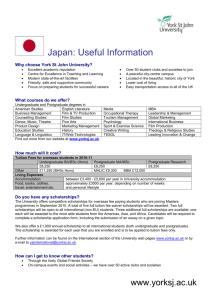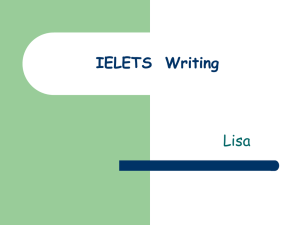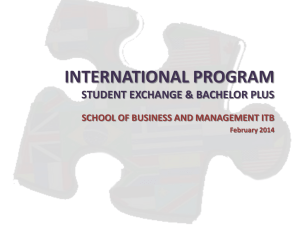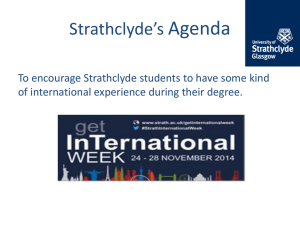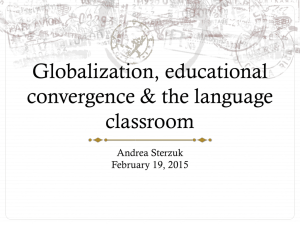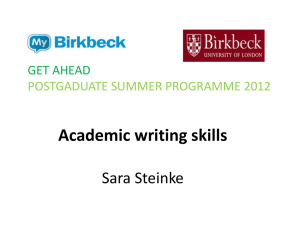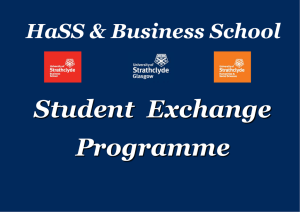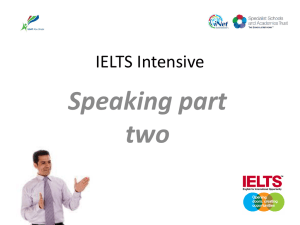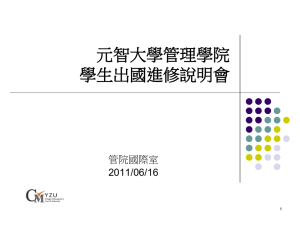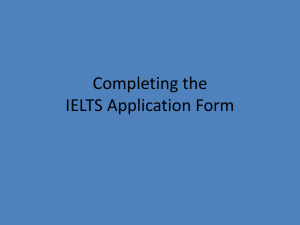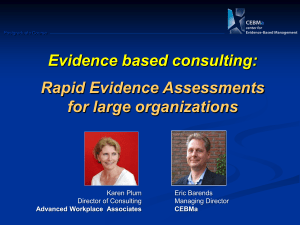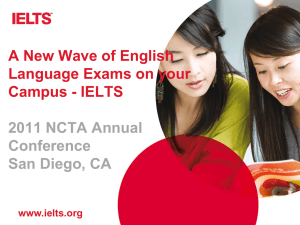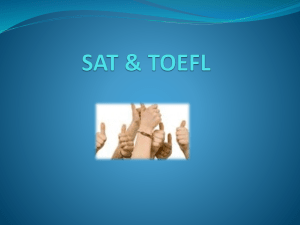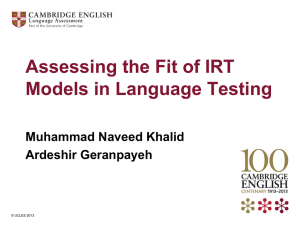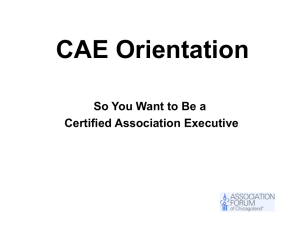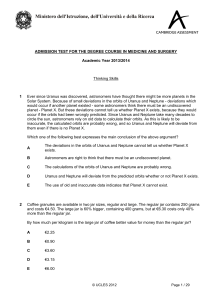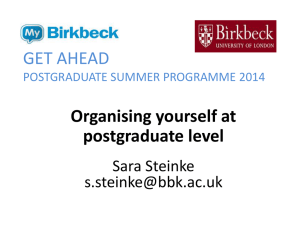Unit 1
advertisement
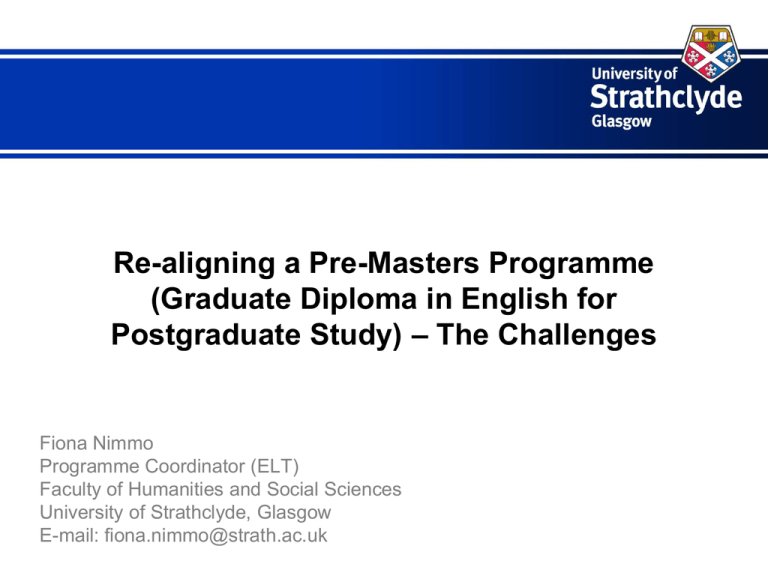
Re-aligning a Pre-Masters Programme (Graduate Diploma in English for Postgraduate Study) – The Challenges Fiona Nimmo Programme Coordinator (ELT) Faculty of Humanities and Social Sciences University of Strathclyde, Glasgow E-mail: fiona.nimmo@strath.ac.uk Graduate Diploma in English for Postgraduate Study Full-time; nine-month University accredited Level 4 (National Qualification Framework Level 6) Pre-Masters programme Originally intended for students wishing to study Masters courses at the University of Strathclyde Business School Attracts students from all subject disciplines (Master & PhD) Agreed actions: Minimum entry level set at IELTS 5.0 or equivalent (IELTS 5.5 in April, 2011- UKBA) Course content to relate to students’ future studies Coursework assessments and examinations reduced and integrated to avoid overlap Writing descriptors linked to learning outcomes Writing descriptors designed to reflect CEFR, UCLES, IELTS, TOEFL iBT, and University of Strathclyde assessment descriptors The original design comprised 120 credits (12 x 10), divided into three Units and spread over three terms. Unit One - English Language Skills (Gen Eng), Reading and Writing Skills (Gen Eng), English for Academic Purposes, Effective Study Skills Unit Two - Academic Reading/Listening, Academic Writing, Speaking & Listening in Specific Academic Contexts, Study Skills for Postgraduate Study Unit Three - Academic Speaking, IELTS Preparation, British Life and Institutions, Postgraduate Study Project Re-aligned programme = 6 classes (6 x 20 credits), divided into 3 Units, spread over 3 terms Unit One – EAP 1, Study Skills for Postgraduate Study Unit Two – EAP 2, Speaking & Listening in Specific Academic Contexts Unit Three – EAP 3, Postgraduate Study Project Assessment integration Effective Study Skills (Unit 1) Study Skills for Postgraduate Study (Unit 2) Study Skills for Postgraduate Study (Unit 1) Vocabulary Log (20%) (Moved to EAP 1) Individual Learning Plan (10%) Individual Learning Plan (10%) Role-play (20%) (Dropped) Reflective Essay (10%) Reflective Essay (20%) Information Research Project (40%) Academic Report (50%) (Overlap ESS) Information Research Project (70%) Open Books Exam (30%) (Moved to EAP 3) Summary Skills Exam (30%) (Overlap EAP 1) Less than half the volume of exams -greater emphasis placed on Information Research project Red = dropped from programme Blue = moved or changed in terms of weighting Equivalency table IELTS CEFR, UCLES (Main Suite) 9.0 8.0 C2, C1 (8.0), CAE (E), CAE (B), CPE (B) CPE (W) 7.0 C1, CAE (B), CPE (W) 6.0-6.5 5.5 B2, B2, FCE (B), FCE (B), CAE (W) CAE (W) 4.0 3.0 B1, PET (B), FCE (W) A2, KET (B), PET (W) C2 (8.5), CAE (E), CPE (B) TOEFL iBT 110+ 110+ 110 90 87 57 39 Strath 70+ 60-69 50-59 40-49 30-39 20-29 1-19 E = Exceptional B = Borderline W = Weak UKBA, 2011 Postgraduate Study Project Learning Outcomes Task Achievement/ Response demonstrate the skills of rapidly identifying key issues, analysing in depth a topic or question and producing a sustained and coherent argument engage critically with sources and be able to incorporate information and ideas from primary and secondary sources in their own academic writing Organisation, Cohesion & Coherence produce clear, well structured text on complex subjects, showing controlled use of organisational patterns, connectors and cohesive devices Language demonstrate the ability to write in language which is accurate, fluent and which shows an appropriate sensitivity to nuances of style and register Presentation follow academic convention using appropriate citations and referencing CEFR IELTS UCLES TOEFL iBT, Argument Task Achievement & Response Content & Target Reader Task Achievement & Response Knowledge & Understanding 1. Task Achievement/Response (knowledge & understanding of subject, logical, well-developed response) Overall & Coherence Coherence & Cohesion Organisation & Communication Organisation & Coherence Communication 2. Organisation, Cohesion & Coherence (text organisation, use of connectors and cohesive devices, paragraphing, presence of introduction & conclusion) Range & Accuracy Grammatical Accuracy, Lexical Resource Appropriacy of Register & Range Accuracy Accuracy 3. Language (fluency, accuracy & appropriacy of language, register, grammar, range of vocabulary) Presentation & Referencing 4. Presentation (layout, spelling, punctuation, ability to follow academic convention) Lexical Resource (spelling) Strathclyde Final Assessment Language Descriptors CEFR B2 = ‘has a sufficient range of language’, ‘can make a distinction between formal and informal language with occasional less appropriate expressions’, ‘shows a relatively high degree of grammatical control’, ‘does not make errors which cause misunderstandings’ IELTS 6.0-6.5 = ‘uses an adequate range of vocabulary for the task’ and ‘makes some errors in grammar but they rarely reduce communication’ UCLES FCE (Borderline), CAE (Weak) = ‘an adequate range of vocabulary’, ‘a number of errors may be present, but they do not impede communication’, and ‘a reasonable, if not always successful, attempt is made at register’ TOEFL iBT 90 = ‘inconsistent facility in word choice may result in lack of clarity and occasionally obscure meaning’ and ‘accurate but limited range of syntactical structures and vocabulary.’ (Independent Writing Rubrics) University of Strathclyde 40-49 = ‘adequate demonstration of learning outcomes’ Final language descriptor: Has generally effective command of language despite some inaccuracies and/or inappropriacies. Register is generally appropriate for the task. Uses a sufficient range of vocabulary. Where unfamiliar language structures are used there may be some inaccuracies in word choice and collocation. Can use and understand fairly complex language structures, particularly in familiar situations. Some syntactical and grammatical errors but these rarely detract from the overall meaning. F. Nimmo (2011) Summary Minimum entry level was set at IELTS 5.5 or equivalent Course content now relates to students’ future studies Coursework assessments and examinations were reduced and integrated to avoid overlap Writing descriptors were linked to learning outcomes Writing descriptors were designed to reflect CEFR, UCLES, IELTS, TOEFL iBT, and University of Strathclyde assessment descriptors The process is transferable to other, similar courses The descriptors can be seen as a ‘work in progress’ - regularly updated and re-designed in light of University of Strathclyde and UKBA regulations, and in light of student, staff, and external examiner feedback Fiona Nimmo, Programme Co-ordinator (ELT) Faculty of Humanities and Social Sciences University of Strathclyde 26 Richmond Street Livingstone Tower Glasgow G1 1XH Scotland Tel: + 44 (0)141 548 5801/3065 Fax: + 44 (0) 141 553 4122
